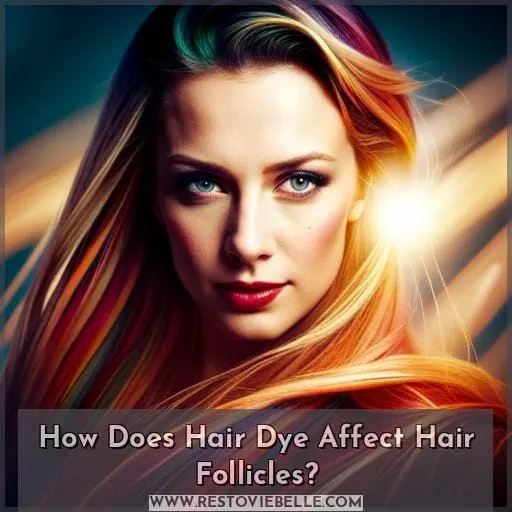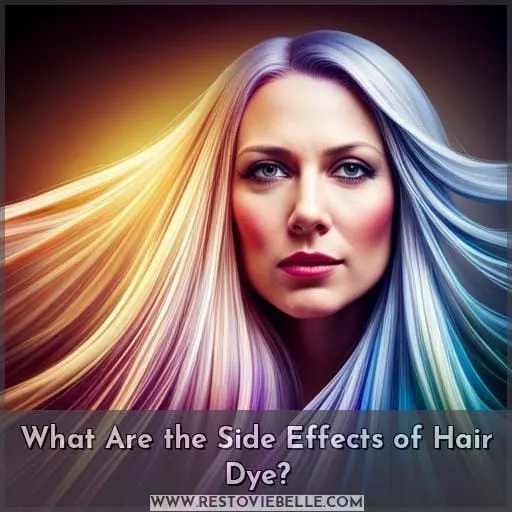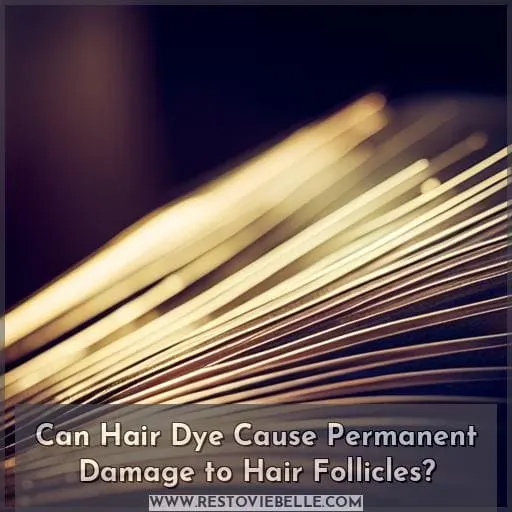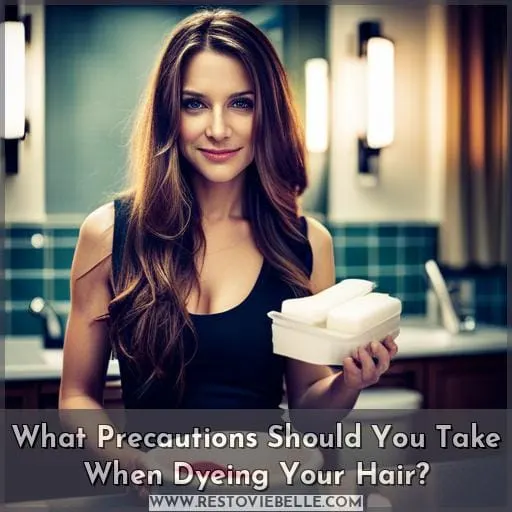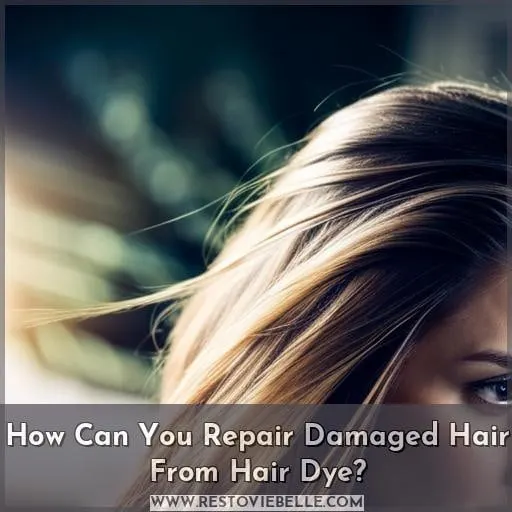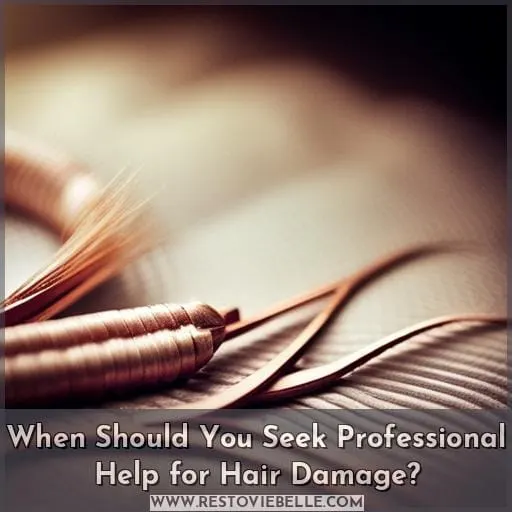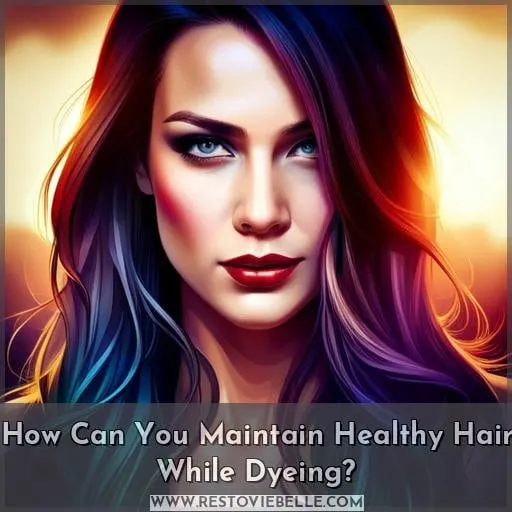This site is supported by our readers. We may earn a commission, at no cost to you, if you purchase through links.
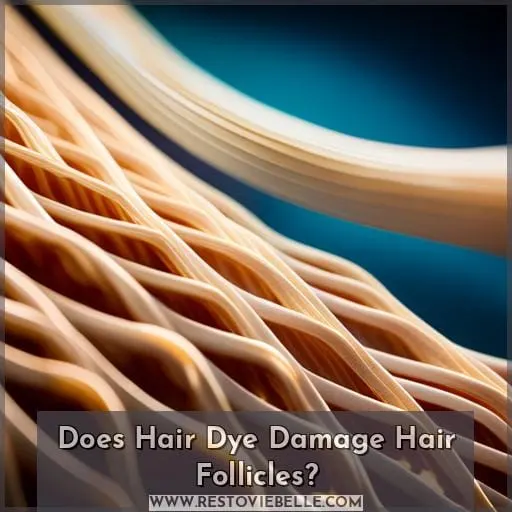 Curious about how hair dye affects your follicles? Coloring your hair can have a lasting impact on the health of each individual strand. But does it damage those tiny, underlying structures – the follicles – that produce new strands? In this article, we’ll explore what chemicals are in hair dyes and discuss their effects on both the structure and strength of our mane, as well as any potential damage to our delicate follicles.
Curious about how hair dye affects your follicles? Coloring your hair can have a lasting impact on the health of each individual strand. But does it damage those tiny, underlying structures – the follicles – that produce new strands? In this article, we’ll explore what chemicals are in hair dyes and discuss their effects on both the structure and strength of our mane, as well as any potential damage to our delicate follicles.
Table Of Contents
- Key Takeaways
- How Does Hair Dye Affect Hair Follicles?
- What Are the Side Effects of Hair Dye?
- Can Hair Dye Cause Permanent Damage to Hair Follicles?
- What Precautions Should You Take When Dyeing Your Hair?
- How Can You Repair Damaged Hair From Hair Dye?
- When Should You Seek Professional Help for Hair Damage?
- How Can You Maintain Healthy Hair While Dyeing?
- Conclusion
Key Takeaways
- Ammonia and hydrogen peroxide in hair dye can weaken hair proteins and lipids, damaging hair follicles over time.
- Harsh chemicals like ammonia and peroxide can cause structural changes in the hair, leading to breakage and compromised follicle health.
- Allergic reactions, irritation, and hair loss can occur as a result of using hair dye compounds such as PPD, ammonia, and hydrogen peroxide.
- Frequent dyeing weakens hair follicles and may result in shedding or baldness due to chronic scalp stress.
How Does Hair Dye Affect Hair Follicles?
When it comes to hair dye, understanding its effects on the hair follicles is essential for maintaining healthy hair. Chemicals commonly found in dyes can damage proteins and lipids, altering the structure of individual hairs as well as causing disruption to their inner and outer structures.
This can lead to weakening or breakage of the delicate strands near the scalp, resulting in compromised health of your follicles over time.
Chemicals in Hair Dye
You should be aware of the chemicals in hair dye, as they can have a damaging effect on your follicles and lead to serious consequences if not used properly.
Commonly found ingredients such as ammonia and hydrogen peroxide damage the structure of hair, leading to breakage and loss.
It is important to seek professional advice before using any type of product on your scalp or hair follicle location for best results with minimal risks.
By following instructions carefully when using dyes, you ensure that you don’t end up with an unwanted outcome: damaged skin cells or weakened strands due to frequent use!
Effects on Hair Structure
When exposed to harsh chemicals, your hair’s inner and outer structure can be weakened and distorted. This leads to breakage when combed or brushed, as well as chemical impact on the protein structures of follicles.
Allergic reactions may also occur due to dyes containing potentially harmful compounds like ammonia and hydrogen peroxide.
Moreover, these structural changes can alter the appearance of hair follicles over time if used too often. It’s important for individuals considering dyeing their hair regularly to understand its effects on both scalp health and overall strength before doing so in order to avoid causing damage that cannot be easily undone afterwards.
Damage to Hair Follicles
Using hair dye too frequently can lead to a weakening of your locks, resulting in potential breakage. Hair follicles may be damaged by the chemicals found in permanent dyes, leading to scalp irritation and even allergic reactions.
Additionally, excessive bleaching causes oxidative damage and protein loss while increasing susceptibility to shedding.
To minimize follicle damage caused by hair dyeing, try using semi-permanent or temporary products with fewer harsh chemicals. You can also opt for conditioner-containing dyes that replenish lipids for improved strength.
However, frequent coloring is still not recommended due to its link with telogen effluvium – baldness associated with chronic stress on the scalp caused primarily through manipulation during coloring processes such as combing and rubbing.
These actions can contribute significantly towards thinning hair strands over time.
What Are the Side Effects of Hair Dye?
When it comes to hair dye, there are many potential side effects that can affect your scalp and hair. Allergic reactions, scalp irritation, and even hair loss are possible consequences of using chemical dyes.
It is important to take precautions when coloring your hair in order to avoid these negative outcomes.
Allergic Reactions
Be aware that dyeing your hair can cause allergic reactions, such as skin irritation and itching. Allergic reactions to chemicals in dyes may result from patch tests or long-term use of products. To minimize damage, it’s important to conduct a patch test before using any hair dye product and seek professional consultation if signs of an allergy occur.
Taking good care of scalp health is crucial for preserving healthy follicles. This can be done by protecting it from sun exposure, avoiding harsh relaxers/perms, and using deep conditioning treatments.
Lastly, limiting the frequency between coloring sessions helps reduce the risk of severe side effects on hair follicle composition associated with frequent use of dyes containing ammonia or hydrogen peroxide.
Scalp Irritation
Scratching your itchy scalp can cause premature hair loss and further damage the follicles, leaving you with a bald spot that feels like an empty desert. Allergic reactions to chemicals in hair dye are common causes of scalp sensitivity and irritation.
This reaction could result from contact dermatitis or irritant dermatitis when exposed to harsh dye ingredients such as ammonia, peroxide, and PPDs.
To minimize the risk of irritation, use professional solutions specially formulated for color fade prevention. Ask your stylist if their products contain natural oils or lipids, which help replenish moisture levels in the scalp and ultimately reduce inflammation associated with allergic reactions caused by hair dyeing processes.
Hair Loss
Frequent hair coloring can cause your strands to loosen and fall out, leading to noticeable thinning. Hair dye damage is often caused by harsh chemicals like ammonia or hydrogen peroxide that weaken the hair follicles.
To prevent this type of hair loss from dye, it’s important to use a quality product and limit treatments to every six weeks.
Allergic reactions are also possible with some dyes, which can further aggravate scalp health issues and cause additional shedding of the hairs in their growing phase. Taking preventive measures such as patch tests before using any new product helps reduce risks associated with color-treating one’s locks.
Deep conditioning treatments provide extra protection against bleaching agents found in many permanent colors.
Can Hair Dye Cause Permanent Damage to Hair Follicles?
Are you concerned about the long-term effects of hair dye on your hair follicles? Hair dyes can cause permanent damage to your scalp and inhibit healthy growth and regeneration. It is important to understand how hair dye works, its potential risks, and ways to reduce or avoid damage when using it.
Long-Term Effects of Hair Dye
Continued use of hair dye can have long-term consequences on your scalp health, with up to 10% of hairs in the telogen phase at any given time potentially being weakened and more prone to breakage. Permanent dyes contain harsh chemicals such as ammonia and hydrogen peroxide, which may damage hair follicles over time.
Semi-permanent coloration is gentler than permanent coloring but still exposes the scalp to potential risks if used too often or incorrectly applied. Prolonged exposure to dye chemicals could weaken follicles, leading to fragility, thinning, shedding, or even alopecia depending on individual sensitivity levels.
It’s important for you to assess your own risk factor when considering using a new product. Conducting patch tests before application are essential steps that must not be skipped! A qualified dermatologist can provide advice tailored specifically for you regarding appropriate care measures and treatments should skin irritation arise due to prolonged contact with certain hair products, including dyes.
Taking these precautions will help ensure protection against possible losses caused by chemical reactions between dyes and delicate scalps while maintaining healthy-looking locks overall!
Hair Growth and Regeneration
Regularly caring for your scalp and hair can help promote healthy growth and regeneration. Hair dye does not necessarily damage the hair follicles, but chemicals in permanent or semi-permanent dyes may weaken them over time if used too frequently.
For this reason, many people opt to use natural alternatives like henna or temporary rinses that do not penetrate into the follicle layer of the scalp.
When using any type of product on your scalp, it is important to conduct a patch test first to avoid potential allergic reactions or skin irritation due to harsh chemicals found in some dyes. Limiting treatments such as bleaching, perms, and relaxers also helps reduce damage caused by strong chemical ingredients present in these products, which could alter both the size and shape of individual hairs as well as impact overall hair density over time.
Additionally, protective styling options are available which limit manipulation during routine grooming processes while allowing you to accessorize without compromising the health benefits associated with certain styles, such as braids.
Be mindful when selecting products for home use—opt for those free from parabens, sulfates, phthalates, etc., known endocrine disruptors linked with hormone imbalance issues, including breast cancer risk.
What Precautions Should You Take When Dyeing Your Hair?
Before dyeing your hair, it is important to take certain precautions. Patch testing for allergies and choosing a high-quality, low-chemical dye is essential for minimizing risks associated with chemical dyes.
Additionally, limiting the frequency of dyeing can help prevent damage caused by excessive manipulation and bleaching of the hair follicles.
Patch Testing for Allergies
Before dyeing your hair, it’s important to conduct a patch test to check for potential allergic reactions. This will help determine if you have an allergy or sensitivity to any of the chemicals in the product before applying it all over your head.
Allergies can cause skin irritation, swelling, itching, burning sensations, sores, and discoloration. If you experience a reaction during testing, consult with a dermatologist as soon as possible. They may suggest an alternative type of hair dye that doesn’t contain harsh chemicals like hydrogen peroxide or ammonia, which can damage follicles and interfere with color changes in the normal lifecycle of hair on our scalp.
Choosing High-Quality Dyes
It’s important to choose high-quality hair dyes to reduce the risk of damage and allergic reactions. Professional consultations can help guide you through safe dyeing practices, enabling long-lasting color with minimal scalp health issues.
Products containing fewer harsh chemicals like ammonia and hydrogen peroxide are preferred for lessening potential risks associated with frequent coloring. Conditioners enriched in proteins or lipids also provide added protection against breakage from bleaching or excessive treatments.
Conducting a patch test before each use is essential as it helps identify any allergies you may have that could worsen after application of the product on larger areas of your scalp or hair strands.
Limiting Frequency of Dyeing
To maintain healthy hair, limit your use of hair dyes to every six weeks. Frequency limits are essential for minimizing damage and preserving the integrity of your follicles.
Taking professional advice is also crucial when it comes to dyeing your hair in order to avoid potential health risks or allergic reactions that could build up over time with frequent dyeing.
Additionally, conditioning treatments can help replenish lipids and proteins lost through repeated bleaching or chemical exposure from harsh ingredients like ammonia and peroxide.
Lastly, strengthening products, such as those containing fatty alcohols, may aid in repairing damaged locks while protecting against future harmful effects from regular coloring practices.
How Can You Repair Damaged Hair From Hair Dye?
If you have recently dyed your hair and are dealing with damaged locks, deep conditioning treatments may be the answer. These treatments help to repair and nourish weakened strands by replenishing proteins in the hair cuticles that were lost due to chemical processing or bleaching.
Deep Conditioning Treatments
Replenish your hair with deep conditioning treatments to protect it from further damage caused by hair dye. Regular treatments can help maintain healthy follicles while promoting moisture balance and repair.
Treatments containing proteins or natural oils are beneficial for restoring the hair’s strength and shine. Seek professional advice on suitable treatment options that provide long-term benefits for your individual needs.
Protein and Lipid-Rich Hair Products
You can replenish weakened hair proteins and lipids with shampoos containing restorative ingredients such as fatty alcohols. Professional recommendations suggest using protein-rich treatments to promote scalp health, protect the hair follicles from damage due to harsh chemicals found in dyes, and restore lost moisture.
Lipid-infused products are also beneficial for maintaining healthy locks by providing deep conditioning benefits that minimize breakage while protecting against fading color caused by dyeing. Products formulated specifically for dyed or bleached hair should be used on a regular basis according to the manufacturer’s instructions.
This will help ensure optimal protection from further damage caused by chemical treatments like those associated with coloring the hair.
Minimizing Heat Styling
Minimizing heat styling is key for repairing hair damage caused by dyeing. Air-dry instead of using a blow dryer, and avoid curling irons or flat irons if possible. Protective hairstyles, such as braids, are also good ways to protect your strands against further damage from high temperatures.
When you do use heat tools, try applying protective products like leave-in conditioners or serums that can help prevent excess drying and breakage to the hair follicles while preserving its texture.
When Should You Seek Professional Help for Hair Damage?
If you’re concerned about hair damage caused by hair dye, seeking professional help is a wise option. Consulting a dermatologist or scalp micropigmentation specialist can provide necessary treatments to address any issues related to hair and skin health.
Consulting a Dermatologist
If you’re experiencing hair damage due to dyeing, consider consulting a board-certified dermatologist for help. A dermatologist can provide treatments and advice on scalp health, allergic reactions, and hair loss related to the use of certain hair dyes or chemicals like ammonia or hydrogen peroxide.
They may also suggest ways to reduce telogen effluvium caused by manipulations during coloring.
- Deep conditioning treatments
- Minimizing heat styling techniques
- Choosing high-quality products based on your individual needs.
Additionally, a doctor can recommend medications if skin discoloration occurs as a result of an allergic reaction.
Scalp Micropigmentation Specialist
To maximize your hair health, you may want to consider consulting with a scalp micropigmentation specialist like Steven Little. This type of professional can help reduce the effects of hair dye on hair follicles and address any existing deformities in the scalp.
Scalp micropigmentation treatments provide numerous benefits, including improving baldness or thinning areas by adding color pigment to create an appearance of fuller-looking strands. During treatment, specialists select colors that match natural pigments for a more realistic look before using tiny needles to inject pigment into the desired area(s).
Aftercare involves avoiding UV exposure and products containing alcohol, as well as regularly moisturizing with gentle cleansers and conditioners tailored for colored locks.
How Can You Maintain Healthy Hair While Dyeing?
Maintaining healthy hair while dyeing is an important part of any hair care routine. Proper care and the use of color-treated products, along with protecting your hair from environmental factors, can help keep it looking its best.
Proper Hair Care Routine
Creating a proper hair care routine is key to maintaining healthy hair while dyeing. Regularly use color-treated shampoo, conditioner, and sun protection. Follow instructions for perming or relaxing. Space out treatments and minimize heat styling. Select products based on your hair type.
Before dyeing, always do a patch test to check for potential allergic reactions such as irritation, itching, or burning sensations. Seek medical attention when necessary. Additionally, opt for conditioner-containing dyes with hydrolyzed silk/milk protein instead of permanent ones, which can cause more damage in the long run.
With these tips in mind, you will be able to keep your scalp and tresses safe from harm caused by dyes!
Using Color-Treated Hair Products
Maintaining healthy hair while dyeing can be a challenge, but using the right color-treated products could help keep your locks luscious. Color-treated hair maintenance should include protective shampoos and conditioners that reduce the potential for allergies or scalp irritation.
Additionally, conditioning treatments with hydrolyzed silk proteins can replenish lipids to strengthen and protect follicles from damage caused by dyes.
Protecting Hair From Environmental Factors
Protecting your hair from the sun, chlorine, and other environmental factors can help maintain its health while dyeing. Wear a hat or scarf when outdoors to block UV rays, which can weaken strands. Avoid swimming in chlorinated pools as it strips away natural oils that keep hair hydrated and healthy.
Use products specifically designed for color-treated tresses, such as conditioners with lipids like fatty alcohols, to replenish lost moisture and proteins that strengthen strands.
Conclusion
Like a butterfly emerging from its cocoon, hair dye can give us a striking transformation, but it can also come with a price. Hair dye can contain harsh chemicals like ammonia and hydrogen peroxide, which can weaken and damage hair follicles.
Permanent hair dyes can penetrate the hair and damage the inner structure, leading to protein loss and oxidative damage.
To reduce the risk of damaging hair follicles, it’s recommended to consult a professional, use natural dyes, and condition the hair regularly. Furthermore, conducting a patch test before using hair dye is essential to check for allergic reactions.
Ultimately, hair dye can cause significant damage to hair follicles, so it’s important to be mindful of the potential risks.

